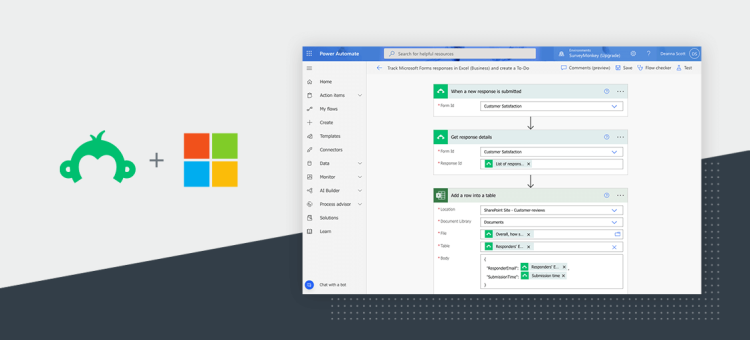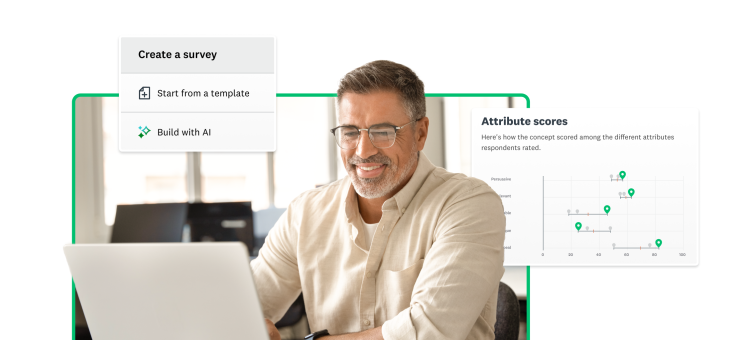Being an effective business leader has always been a balancing act: How do you make the best decisions possible while ensuring they’re being made quickly enough to make an impact? The stakes are even higher for today’s leaders, who make high-impact decisions every day—perhaps even several times a day.
In our recent survey of 250 C-level¹ executives, 88% described feedback data as “very” or “extremely valuable” for making business decisions.
Furthermore, executives at the companies that value feedback the most were nearly 20x more likely to feel “extremely confident” in their ability to pivot based on new information, compared with executives at companies that don’t prioritize feedback.
There’s no question feedback is valuable, but it’s not always easy to get quality insights when we need them. Too often the data sits in proliferating silos across organizations, and retrieving those insights requires knowing just the right person or secret handshake to access. In fact, 52% of the C-level execs we asked reported they’re concerned about how to break silos to keep employees connected. (Read more from that research in our decision-making guide.)
Capture insights and collaborate in real-time with Microsoft apps
So how do decision-makers break down silos to get access to important insights to make timely, informed decisions?
Real-time collaboration and insights are key for making informed decisions and taking timely actions across an enterprise. This is where SurveyMonkey and Microsoft can help.
Collaboration is on the rise, and today’s hybrid workforce relies on Microsoft apps more than ever, according to the Microsoft Work Trend Index. When researchers compared collaboration trends in Microsoft 365 between February 2020 and February 2021, they found that:
- Time spent in Microsoft Teams meetings more than doubled (2.5x) globally—and continues to climb
- The average Teams user is sending 45% more chats per week; and that percentage continues to rise
- There’s a 66% increase in the number of people working on documents
We’ve been helping teams to collaborate and drive decisions within Microsoft’s enterprise products for years by enabling them to generate and analyze employee and customer feedback data right inside the Microsoft apps they use daily.
This week, we released capabilities that make this connection even stronger across Microsoft Teams, Microsoft Power BI, and Microsoft Power Automate, while ensuring users can continue to access SurveyMonkey Enterprise instantly with Office 365 single sign-on. With SurveyMonkey Enterprise connected across the Microsoft ecosystem, organizations can capture feedback, uncover insights, promote collaboration, automate workflows—and fuel collaboration and business decision-making right from where they work everyday.
Manage and analyze feedback within Microsoft Teams personal app
Microsoft Teams users have been able to launch SurveyMonkey surveys, quizzes, and polls from inside Teams for a while to easily capture in-the-moment, structured feedback. Now users can also manage all surveys and view analytics directly from within the Teams personal app—a personal, private hub for your in-progress work. Teams users can manage survey tasks (create, edit, view) for all their surveys in one place. They can share any survey to one or more Teams Channels, Chat, or Outlook using a web link collector. And they can easily view the analytics for any survey.
Automate feedback workflow at scale with Microsoft Power Automate
With Microsoft Power Automate, teams can automate workflows with embedded survey insights at scale, without repetitive, manual work—saving precious time and energy. The new SurveyMonkey Power Automate Connector is seamlessly integrated with Microsoft and 500+ other apps so users can automate critical workflows for a wide range of use cases, flowing feedback data into other business systems to perform insights-driven and proactive actions faster. Users can tap into pre-built Automate templates and tools that require little technical knowledge, and initiate insights-driven actions effortlessly and without human error. These automated workflows also ensure data exchange is secure and compliant, protecting organizations’ sensitive data.
With Power Automate, users can apply logic to set triggers for certain automated actions. For example, if a customer NPS® score falls below a certain threshold, Power Automate can generate Salesforce tickets automatically that alert customer success teams to address customer concerns. Organizations can use Power Automate in a wide range of scenarios to trigger the next right action based on customer and employee feedback for users in HR, customer experience, marketing, product, and IT, as well as within the healthcare industry. Let’s go over some examples in the following.
Improve employee experience through workflow automation
HR and people managers can use SurveyMonkey Enterprise with Power Automate to stay on top of employee engagement, while cutting down on repetitive, manual tasks. With feedback driving workflows, people managers can better drive the following:
- Proactive sentiment monitoring: people managers are notified automatically if employees respond negatively in employee engagement surveys.
- Streamlined employee insights: employee feedback in quarterly surveys can be automatically updated to Sharepoint and Power BI for trending analysis and other deep-dives.
Drive better customer experience with feedback-driven workflows
Customer experience teams can drive better CX effortlessly by taking feedback-driven actions to drive the following:
- Proactive churn prevention: customer success teams can be notified if customers provide a low NPS score in surveys, so teams can take swift corrective action.
- Holistic customer insights: unique customer responses to research surveys can be automatically updated into Salesforce accounts for follow-up or to Power BI for analysis.
- Customer sentiment awareness: insights from customer satisfaction surveys can be automatically shared to Microsoft Teams for easy and broad access across the organization.
Create more engaging brands by sharing brand perception data with key stakeholders
Brand teams can better monitor brand perception and identify ways to improve brand efficiency when feedback drives certain actions. Here are some examples:
- Broad trending awareness: key stakeholders can quickly see brand tracking data when it’s automatically shared using Microsoft Teams.
- Impact driver insights: key results from pre- and post-campaign surveys, as well as competitive tracker studies can be automatically visualized by Power BI to identify the drivers of brand lift, as well as brand opportunities and threats.
Invent more engaging products based on feedback
Automated workflows can help product teams more quickly and better create optimal user experiences that are based on user feedback. Here are some examples of how:
- More streamlined product fixes: product issues raised in customer satisfaction surveys can be flagged to the product teams through automatic Jira ticket creation.
- Better informed product roadmaps: results of user experience surveys can be automatically integrated into and visualized by Power BI to identify critical areas to build or improve upon.
- Enable proactive sentiment tracking: product teams can be sent instant emails if customer feedback contains low NPS scores.
Streamline IT processes to improve business efficiency
By automating workflows, IT teams can more effectively meet the demands of the business. Here’s how:
- Save time with intuitive builders: IT teams can leverage the drag-and-drop workflow builder, using existing Power Automate templates to automate workflows or robotic process automation to automate even legacy on-premise solutions.
- Secure data exchange: users can exchange data securely through Power Automate connectors, bypassing the need to download or re-share data individually and thereby minimizing potential security breaches.
- Consolidate tools: IT can enable users to flow survey insights directly into other apps through Power Automate, without needing to maintain other automation tools.
How automated workflows help healthcare professionals improve quality of care
Automated workflows help minimize manual, unsecure tasks, giving healthcare professionals more time to improve the quality of patient care.
For example, healthcare teams can enable patients to provide health information through SurveyMonkey Enterprise, which has HIPAA-compliant survey features, prior to their visit. This information can then be automatically updated to HIPAA-compliant SharePoint to reduce delays in treatment and potential medical errors.
Providers can also enable patients to submit post-visit CAHPS (Consumer Assessment of Healthcare Providers and Systems) surveys, with clinicians notified automatically of warning signs or negative sentiment for timely follow-up.
Generate big-picture insights by integrating feedback data into your Power BI dashboards
Microsoft users can connect SurveyMonkey feedback with Power BI to get a more-comprehensive data story. Users can incorporate all survey feedback in dashboards, combining feedback with other operational or behavorial data for a single, holistic data view and to generate robust analytics. Users can then create highly visual reports, charts, and graphs and share them from any device. Using interactive dashboards (Power BI Desktop or Power BI online), Power BI users can leverage data models to drive better business decisions. With Power BI integration, you can generate deeper insights and tell a compelling–and actionable–data story.
Put the power of insights to work for your organization today
Feedback-based decisions and smart actions lead to happier employees and customers—and positive growth. Better business decisions come from having accurate and comprehensive insights when you need them most. Achieving this means freeing your data from siloes and enabling your teams to use it collaboratively. Together, SurveyMonkey and Microsoft enable teams to access the insights they need, when they need them, from within the Microsoft apps they use everyday.
¹Momentive study of 257 U.S. adults who are employed full-time as C-level executives, conducted March 9–16, 2021.
Net Promoter, Net Promoter System, Net Promoter Score, NPS and the NPS-related emoticons are registered trademarks of Bain & Company, Inc., Fred Reichheld and Satmetrix Systems, Inc.
# # #



